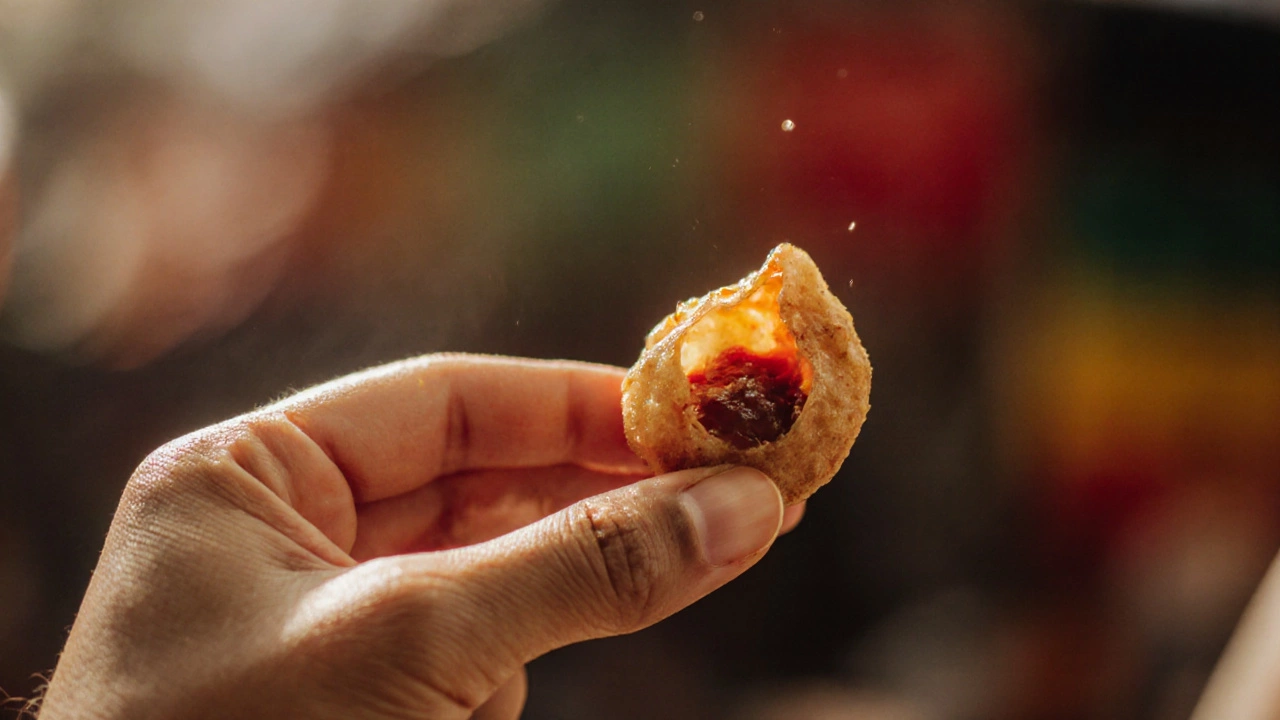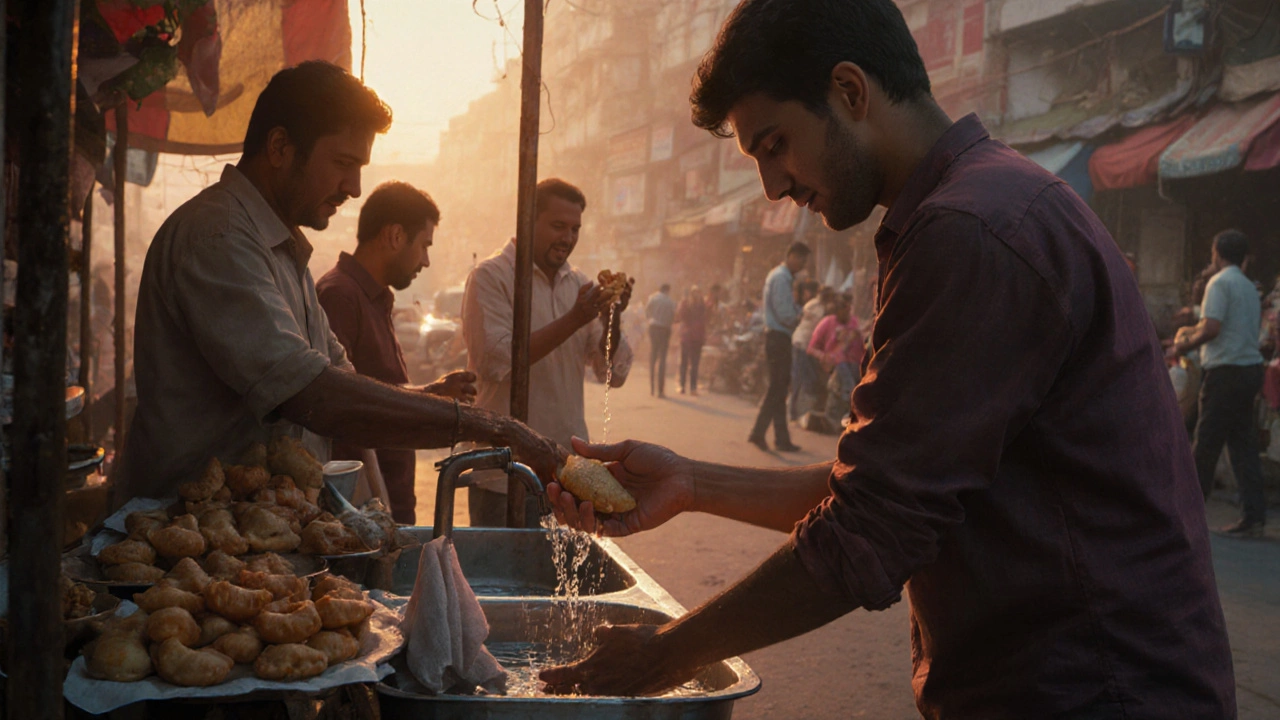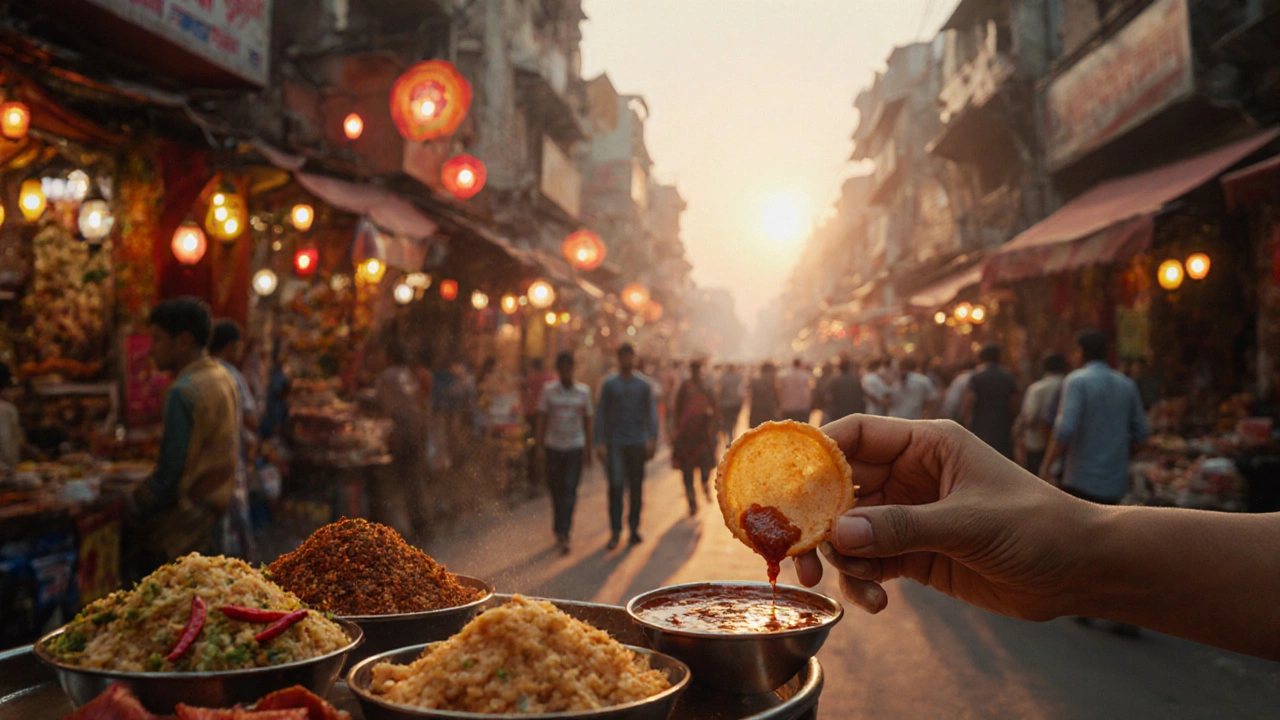Key Takeaways
- Hand eating in India dates back thousands of years and is rooted in cultural, practical, and health beliefs.
- Ayurveda views the hand as an extension of the digestive system, helping enzymes mix with food.
- Most popular street snacks - chaat, panipuri, samosas - are designed for finger consumption.
- Modern hygiene concerns have introduced alternatives, but many locals still prefer the tactile experience.
- Travelers can join in respectfully by following a few simple etiquette tips.
When you wander through the bustling lanes of Delhi or Mumbai, Indian street food is a vibrant mix of flavors, colors, and aromas that often invites you to eat with your hands. The sight of people scooping up hot puri, pinching a crispy samosa, or rolling a dosa around a bite might look unusual if you’re used to forks and knives, but there’s a deep‑rooted logic behind it.
First, let’s understand the hand eating tradition in India. It isn’t a quirky habit; it’s a cultural practice that has survived for centuries, intertwining history, health, and social etiquette.
Historical Roots: From Ancient Banquets to Modern Bazaars
Archaeological records from the Indus Valley Civilization (c.2600‑1900BCE) show that people used their fingers to enjoy meals. Ancient texts like the “Manusmriti” and “Ayurveda” even mention the word “hasta‑bhojana” - literally, eating with hands. In a time when metal cutlery was a luxury, the humble hand was the most accessible tool.
During the Mughal era, royal kitchens introduced elaborate dishes, but the street vendors that sprouted outside the forts kept the finger‑food format for speed and convenience. By the 19thcentury, the British observed Indians eating with hands and noted it in their travel diaries, solidifying the practice as a cultural hallmark.
Cultural Significance and Etiquette
In Indian culture, the right hand holds a sacred status. The left hand is traditionally reserved for hygiene‑related tasks, so food is always taken with the right. This etiquette stems from the belief that the right hand is “pure” and is used for greeting, giving, and, of course, eating.
Respectful hand‑eating also signals a sense of community. When you share a plate of chaat with friends, everyone uses the same communal bowl, fostering a feeling of togetherness. The tactile interaction creates a bond that a fork can’t replicate.
Practical Reasons: Texture, Temperature, and Taste
Many Indian snacks are intentionally crafted for finger consumption. A crispy papdi, a fluffy puri, or a soft roti can be broken, folded, or scooped effortlessly with the fingertips. This “hand‑friendly” design serves two purposes:
- Texture control: By feeling the food, you can gauge how crunchy or soft it is before the first bite.
- Temperature management: Holding a steaming hot samosa in your palm allows the heat to disperse evenly, preventing burns.
Moreover, the oils and spices adhere to the skin, letting the hand act as a natural “saucebrush.” When you dip a piece of pakora into chutney, the oil on your fingers helps spread the flavor across every bite.

Ayurvedic Perspective: The Hand As a Digestive Tool
The ancient Indian medical system, Ayurveda, considers the hand an extension of the digestive tract. According to Ayurvedic texts, the fingertips contain thousands of sensory receptors that stimulate saliva production. More saliva means better breakdown of starches and fats before the food even reaches the stomach.
Ayurveda also emphasizes “Agni,” the fire of metabolism. When you eat with your hands, the gentle pressure and movement are believed to ignite Agni, aiding nutrient absorption. Modern science backs up part of this claim: increased mastication (chewing) improves nutrient uptake, and the extra sensory input from the fingertips can trigger a similar digestive reflex.
Signature Street Foods Made for Hand Eating
Below are some of the most beloved Indian street eats that were literally designed for your fingers:
- PaniPuri: Hollow crispy shells filled with spiced water, tamarind chutney, and a mix of potatoes and chickpeas. You pop the whole bite into your mouth.
- VadaPav: A deep‑fried potato fritter sandwiched between buttered bread rolls. Pick it up, bite, and the juices soak into the pav.
- Samosa: Triangular pastry stuffed with spiced potatoes or meat. The crisp edges are perfect for pinching.
- Chaats (PapriChaat, BhelPuri): A medley of puffed rice, sev, chutneys, and crunchy papri. The mixture is tossed in a bowl, and you scoop it with your fingers.
- Dosa: Thin rice‑lentil crepe rolled around a potato filling. Rolling it up in the hand keeps the fillings inside.
Notice a pattern? All these items are bite‑sized, lightly coated in sauce, and hold together when pressed gently.
Modern Concerns: Hygiene and Changing Habits
With rising awareness of food‑borne illnesses, some street vendors now offer disposable paper plates and plastic forks. Health officials in major Indian cities recommend washing hands with water and soap before eating. Still, many locals argue that a quick rinse with water (often using a small bucket at the stall) is sufficient, especially when the food is served hot.
Tourists sometimes hesitate, fearing germs. Studies from the Indian Council of Medical Research (ICMR) in 2023 found that the bacterial load on clean, rinsed hands is comparable to that on a stainless‑steel spoon, provided the food itself is cooked thoroughly.

Tips for Travelers: How to Eat Indian Street Food With Respect
- Wash your hands. Most stalls have a small basin; use the provided water and a clean cloth.
- Use only your right hand. If you’re left‑handed, gently switch to the right for the food portion.
- Start with the outer parts of the food. For a samosa, break off a corner first; this reduces the chance of sauce spilling.
- Don’t over‑stuff. Pinch a bite‑size piece and enjoy it in one go - it keeps the flavors balanced.
- Show appreciation. A simple “thanks” (dhanyavaad) after the snack signals respect for the vendor’s craft.
Hands vs. Utensils: A Quick Comparison
| Aspect | Hand Eating | Utensils |
|---|---|---|
| Flavor Experience | Hands release natural oils, enhancing taste. | Utensils may separate sauces from the food. |
| Convenience | No need for cutlery; perfect for on‑the‑go. | Requires extra cleanup, especially on streets. |
| Hygiene | Depends on hand‑washing; traditional rinsing is common. | Perceived cleaner, but utensils can carry bacteria too. |
| Cultural Authenticity | Fully embraces local customs. | May be seen as distancing from the experience. |
| Temperature Control | Hands absorb heat, preventing burns. | Utensils may cause hot bites to burn the mouth. |
Conclusion: Embrace the Tactile Tradition
Eating Indian street food with your hands is more than a novelty; it’s a practice that blends centuries‑old tradition, sensory pleasure, and even digestive science. Whether you’re navigating the lanes of Kolkata’s New Market or grabbing a quick PavBhaji in Mumbai, the next time you feel the warm, crisp texture in your palm, remember you’re part of a cultural story that connects you to millions of Indians who’ve shared meals the same way for generations.
Frequently Asked Questions
Is it safe to eat street food with hands if I’m traveling?
Yes, as long as you wash your hands with water and soap (or use the rinsing station most stalls provide). The food is usually cooked at high temperatures that kill harmful bacteria.
Why is the left hand considered unclean?
Traditional Indian etiquette reserves the left hand for personal hygiene tasks. Using the right hand for eating respects that cultural norm and is seen as polite.
Can I use a fork if I prefer not to touch food?
You can, but you might miss out on the authentic flavor experience. Some vendors offer small plastic forks for tourists-use them if you’re uncomfortable, but try at least one bite with your hand.
Does hand eating improve digestion?
According to Ayurvedic principles, the tactile stimulation of the fingertips triggers saliva and digestive enzymes, which can aid in better breakdown of food.
What are some etiquette tips when sharing a communal plate?
Use your right hand only, take small portions, and avoid touching the same spot repeatedly. Saying “dhanyavaad” after the meal shows respect.
